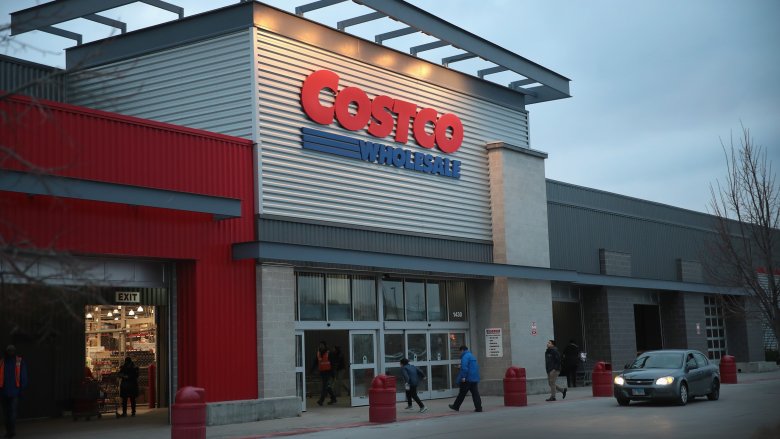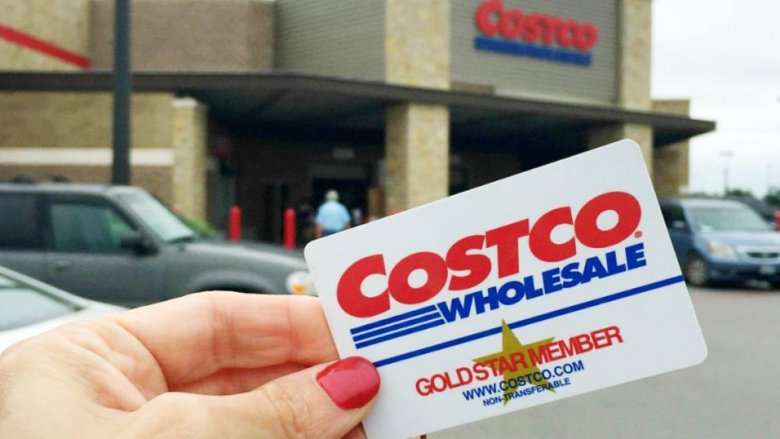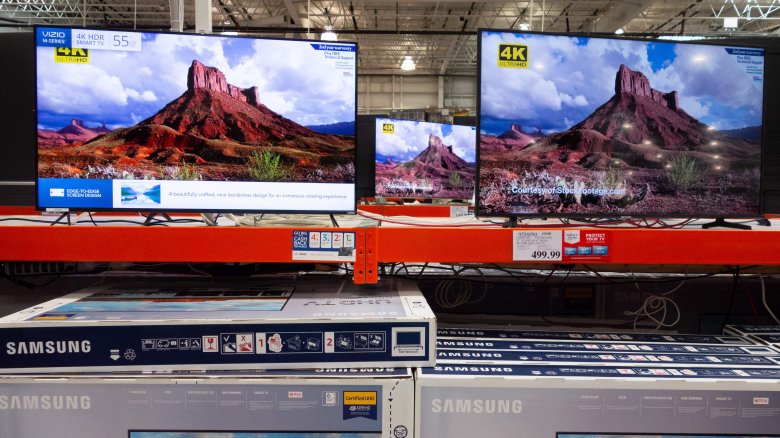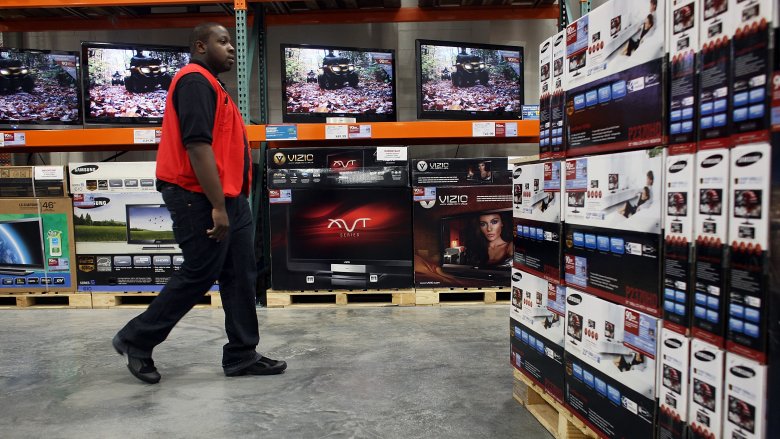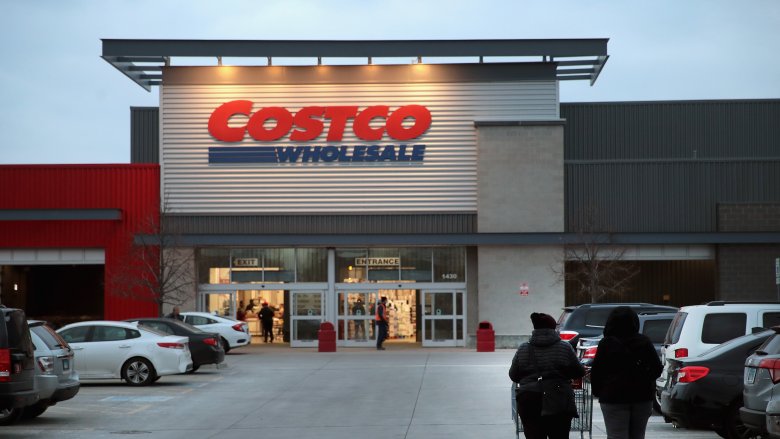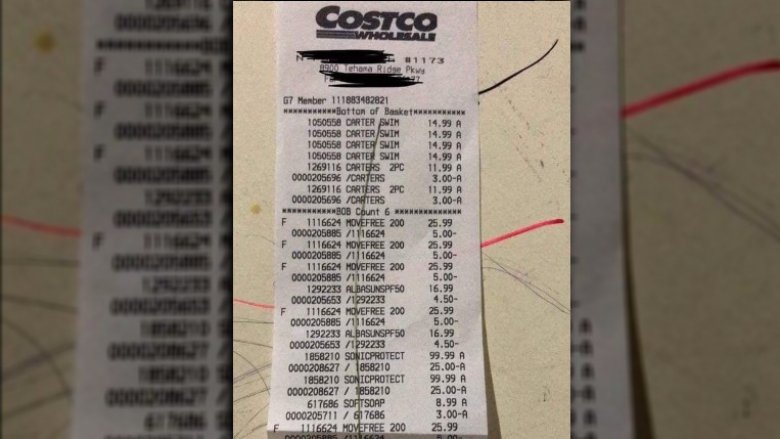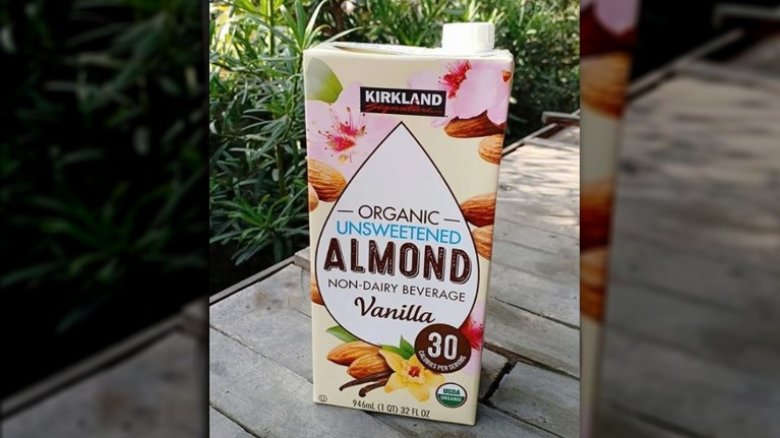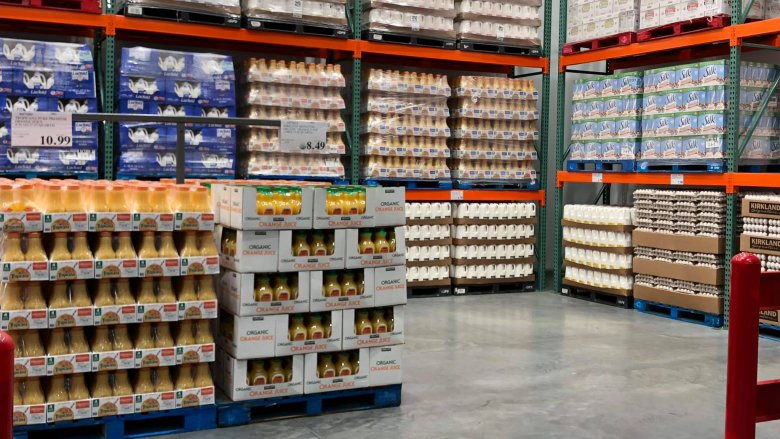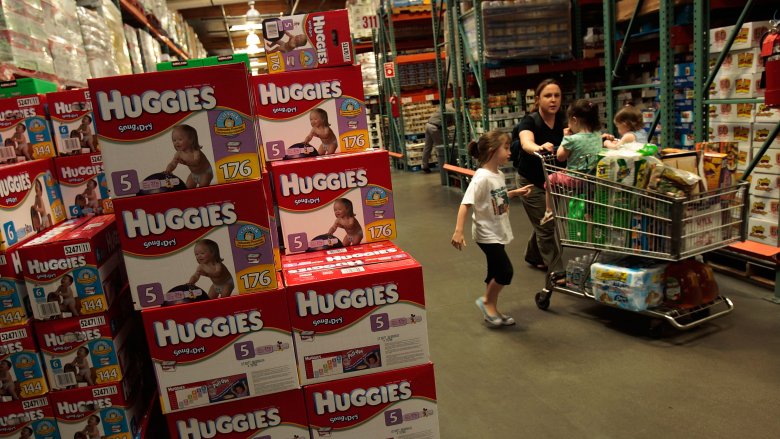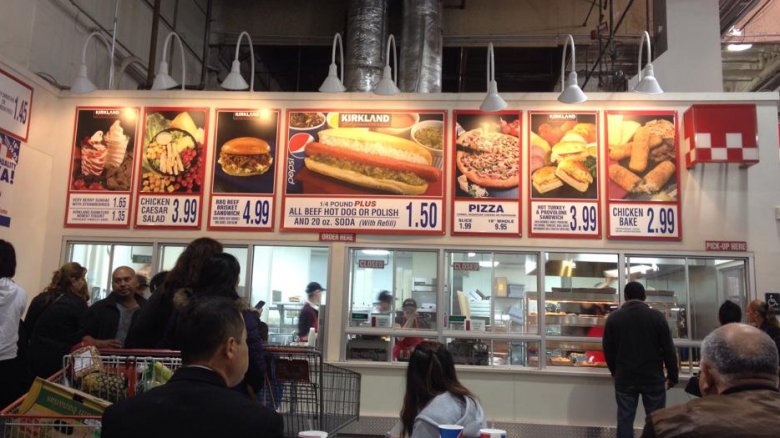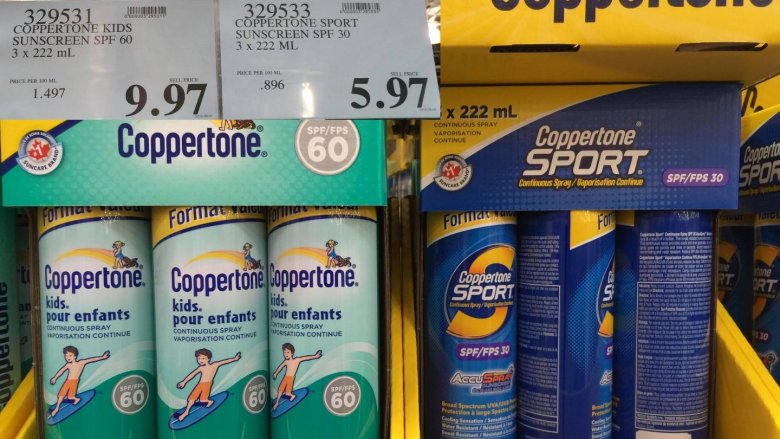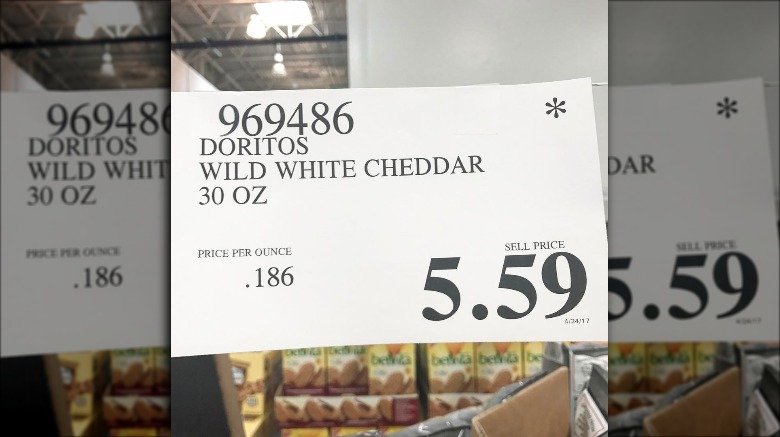The Truth About Costco's Really Low Prices
Since 1983, Costco has built its reputation as the place to go for big items at low prices. The membership warehouse club, which launched in Seattle, Washington, has become an international force. As of 2018, Costco has 768 warehouses worldwide, including 1 in Iceland, and has more than 94 million loyal members across the globe.
Since it entered the market, Costco has grown its brand and its massive cult following by offering the lowest price possible on its products. And in a world where the competition includes the likes of Amazon and Walmart, price is an important way to stand out. "Price is at the top of our list. When prices are going down... we want to be the first to do down," Costco's CFO told company investors in 2018.
But how can the retailer maintain their rock-bottom prices when everyone else is trying to do the same? From a bare-bones store design to cracking down on theft, the warehouse club has put a lot of cost-saving measures in place to make sure they stand out in a crowded field, and are able to maintain the lowest prices on the goods they sell.
Members pay to keep Costco's prices low
Shopping at Costco is an experience unlike any other. Where else can you shop for great deals, grab a cheap lunch, and fill up your gas tank in one place? But those great deals aren't for everyone. Costco's famously low prices are only available to members who pay to have access to the warehouse club.
For $60, a Gold Star Membership gives members exclusive access to shop at any Costco location worldwide. In addition to shopping privileges, upgrading to a $120 Executive Membership makes members eligible to receive 2 percent cash back on qualifying purchases.
And those membership fees are going a long way to help the company's profit margins. As CNN Business reported in 2018, about 75 percent of Costco's profits come from the annual membership fees they collect. And because Costco earns so much income from membership fees, it can resist the urge to mark up the price consumers pay on the products they sell.
Although you may think you shouldn't have to pay to shop, an overwhelming majority of Costco members believe that the price of the membership is more than worth it. According to CNBC, the company has a 90 percent renewal rate on memberships in the United States and Canada.
Less inventory means lower prices at Costco
Costco warehouses are massive, which is why it's so easy to lose an entire afternoon shopping at one. The average Costco store is nearly 145,000 square feet in size, but even with all of that enormous square footage, Costco offers a limited number of product choices compared to their retail competition. A typical Costco warehouse is stocked with just 4,000 different products for sale, compared to about 30,000 at most supermarkets, and 142,000 at Walmart SuperCenters.
As then-CEO Jim Sinegal told The Motley Fool, of those 4,000 products that Costco offers, 3,000 of them are everyday items like peanut butter and pasta sauce. The other 1,000 items are rare finds such as high-end apparel items that change on a regular basis. And because they deal with a limited number of brands, Costco is able to buy their products in bulk at a cheaper price and pass the savings along to their customers.
Treating employees well saves Costco money in the long run
In addition to providing a positive shopping experience for their members, Costco is committed to making sure their employees are happy when they come to work each day. The company believes that keeping the people who work for them happy helps reduce turnover and instances of employee theft, all things that can cost the company money and drive prices up.
In addition to providing a robust benefits package that includes health insurance, stock purchase options, and a retirement savings plan, the company shows their employees that they are valued by paying them at a higher rate than other well-known retailers. According to Barron's, Costco has a $15 hourly minimum wage, which is higher than most of its competition, including Target's $13 per hour, and Walmart's $11 per hour.
And all of the company's dedication to its employees is paying off. A 2018 Indeed survey of top-rated workplaces named Costco number when it came to compensation and benefits.
Costco doesn't do advertising, and that helps keep prices low
If you've ever wondered why you've never seen a Costco ad, it's because there aren't any, a fact which saves the company around 2 percent in costs each year, according to The New York Times.
The company does not have a public relations staff and spends next to nothing on traditional advertising compared to their competition. Meanwhile, according to Business Insider, Amazon's 2017 advertising and promotions budget was $6.3 billion, Walmart spent $3.1 billion in 2018, and Target had a 2017 budget of $1.4 billion. The money Costco saves on marketing allows them to sustain prices that are lower than the competition and that keep their loyal customers coming back. As then-CEO Jim Sinegal told The Motley Fool in 2013, "We consider [advertising] evil. Because it costs money; anything that is going to raise our price on merchandise is bad. We've got to have that type of an attitude."
Costco does send direct mail to potential new members and promotional coupons to current warehouse members, but primarily relies on word of mouth to expand its reach. The brand also gets a boost from high profile celebrity fans like Kris Jenner and Jessica Alba, and social media accounts dedicated to Costco lovers like Costco Does It Again, which has over 360,000 followers (as of July 2019).
Checking receipts helps cut down on theft at Costco
For most retailers, theft isn't just annoying, it can have a major impact on their bottom line. A National Retail Federation survey found that merchandise theft cost retailers in the United States nearly $50 billion in 2016. Customer shoplifting makes up over 36 percent of the overall theft, with the $1000 and over average dollar loss category being the highest at over 22 percent per incident.
But Costco has made it their business to keep shoplifting to a minimum in their stores. Most locations have only one entrance and exit location, and don't even think about leaving your local Costco without having your receipt checked by an employee. And their plan is working. As Costco CFO Richard Galanti told Barron's, the company's estimated loss to shoplifting is just 0.11 to 0.12 percent of their sales, which is far less than the retail average of 1 to 2 percent.
And since theft isn't cutting into the company's profits, Costco can afford to maintain the low prices their customers love.
Costco's private label brand is a low-cost alternative
From cleaning products to pet food, Costco is able to live up to its customers' low price expectations with their exclusive Kirkland Signature brand of products — a less expensive alternative to many of the national brands they carry.
As The Wall Street Journal reported, a Kirkland version of a product comes to market when Costco believes that a national brand isn't being offered at the lowest possible price. Costco's goal is to offer their Kirkland products at a price that is at least 20 percent less than the name brand version without sacrificing any of the quality that customers come to expect.
And their customers have been happy to embrace the Kirkland brand. 2018 sales of Kirkland Signature products were up to more than $39 billion in 2018 from $35 billion in 2017. According to Reader's Digest, Kirkland brand olive oil, maple syrup, and almonds are among the best items they offer at a fraction of the price of their name brand competitors.
The no-frills Costco store design saves money
Customers don't come to Costco expecting to see fancy store displays and beautiful product staging. Costco locations around the world are known for being warehouses with pallets of products stocked as far as the eye can see, and their millions of members are okay with that.
In fact, the company's bare-bones design model helps them save money, and in return, offer the low product prices that their members have come to expect. As Business Insider reports, Costco saves money by not hiring dedicated staff to unpack boxes and create elaborate product displays. The items are essentially unloaded directly on to the warehouse floor with little regard for aesthetics.
In addition to saving money on staff, Costco's no-frills business model allows warehouses to save money on operational costs as well. According to Quora, energy efficient warehouses use skylights and take advantage of daylight. As a result, they don't have to use as much electricity, which can cut into their profit margin.
Costco goods are marked up less than other retailers
Another way Costco passes savings along to their members is by maintaining good relationships with their suppliers. As CNN Business points out, vendors trust that Costco will pass any savings they provide along to the customers, and that results in a sales boost for them. In the long run, obviously, those kinds of deals benefit Costco's members in the form of low prices, and it's a win-win for everyone. And because Costco earns so much of its income from annual membership fees, the warehouse club can resist the urge to mark up the price consumers pay on their products in an effort to keep more of the profit for themselves.
According to Investopedia, Costco keeps its markups capped well below that of its retail competition. The average markup at Costco is 11 percent, compared to Walmart at 24 percent, and Home Depot at 35 percent, according to Fortune (via Business Insider). CBS News adds that Costco makes a point of not marking up an item more than 15 percent.
The Costco food court prices are really low, too
A trip to Costco isn't complete without a visit to the food court, which is arguably one of the best places in the store to find great deals. The menu is loaded with inexpensive options including pizza, hot dogs, and salads that help the warehouse club lure in shoppers.
One of the most popular items on the food court menu is the long-standing hot dog combo. $1.50 gets you a 1/4-pound hot dog with a 20 ounce soda. The idea was first tested In 1984, when Hebrew National set up a hot dog cart outside of a San Diego store and sold their $1.50 combo. The combo has been so successful for Costco that they have kept the price the same for over 30 years, according to Reader's Digest. Similarly, the price of the $9.95 pizza hasn't changed since it landed on the menu in 1989.
The company isn't making much of a profit by keeping their food court prices so low. In fact, the hot dog meal is well-known as a loss leader. But as the Costco Connection mentioned, the company views the food court as an added value benefit to their members. In addition to making hungry shoppers happy, the inexpensive meal options help members justify the cost of their membership, and makes Costco a shopping destination for the entire family. Plus, those frequenting the food court for a super-cheap lunch are probably spending plenty in the store, too.
Keep up with the calendar to know when to get the best prices at Costco
One of the biggest parts of getting the best deals at Costco is knowing exactly when you should shop for them. If you need help keeping track of all of the deals, look no further than the Costco Clearance Calendar on Costco.97. The online calendar is a month-by-month guide to the Costco sales cycle. Costco members can learn what is new and what will be on clearance so you can determine the best times of year to shop for the items you want at the lowest prices.
If you're not convinced that the calendar gets it right, and you're worried about seeing an item you purchased at full price get discounted in the store soon after, you can breathe a sigh of relief. Customers can take advantage of Costco's 30-day price protection plan. According to Tough Nickel, the policy allows you to bring an item back into the store for a refund of the price difference within 30 days of purchase.
Pay attention to Costco's price signs for clues about discounts
According to Uproxx, Costco store managers have a code by which they price the items in their stores. Understanding the meaning of those price points can help you understand which deals you should jump on right away and which are worth waiting for a little while longer.
Items with a price that ends in $0.97 are clearance items that have been discounted by the store manager, as Business Insider explains. Costco.97 adds that these items are either seasonal products or merchandise that isn't selling well in the store. The managers lower their prices in order to make room for new inventory on the warehouse shelves.
Items that end in $0.88 or $0.00 have also been marked down by the store's manager. These products are usually either a floor model or a last remaining item in the product's category.
A price that ends in $.89, $.79, $.69, $.59, or $.49 indicates that the product is being sold at a special deal directly from the manufacturer. These special deals are often a way for the manufacturer to test out a new product in the market.
And if you see an asterisk, you'd better grab that product right away, because that indicates it's going away and not coming back.
